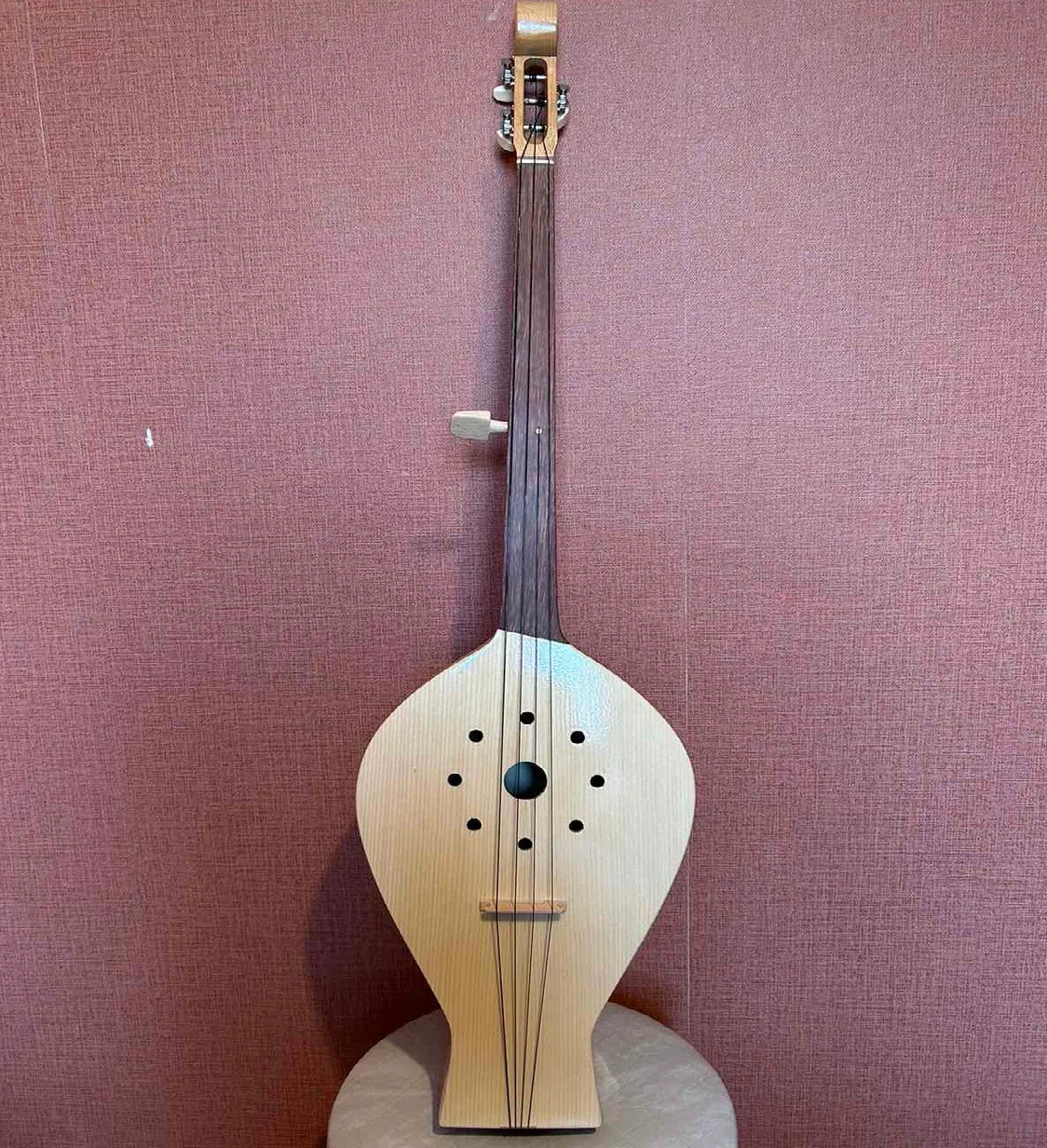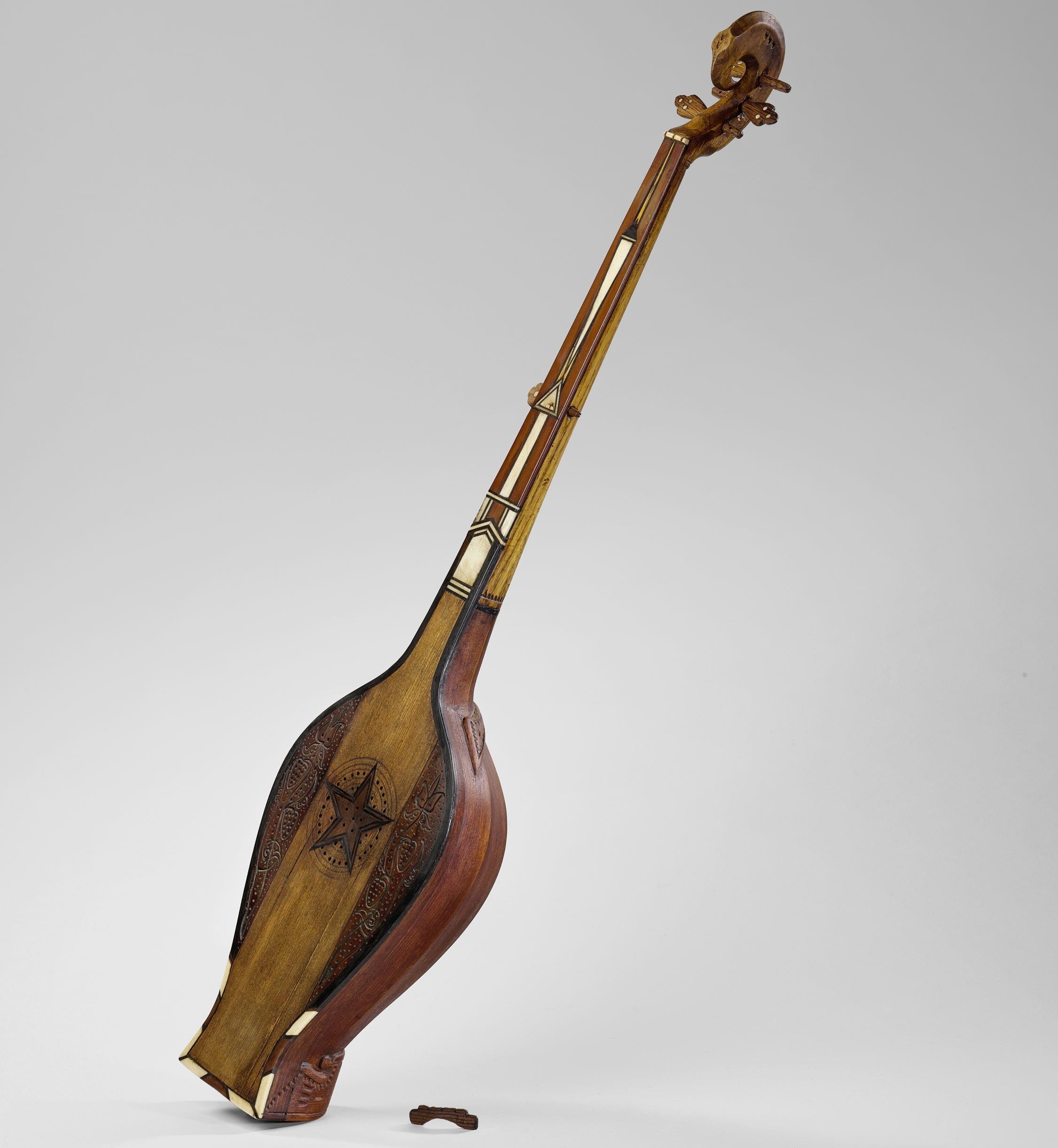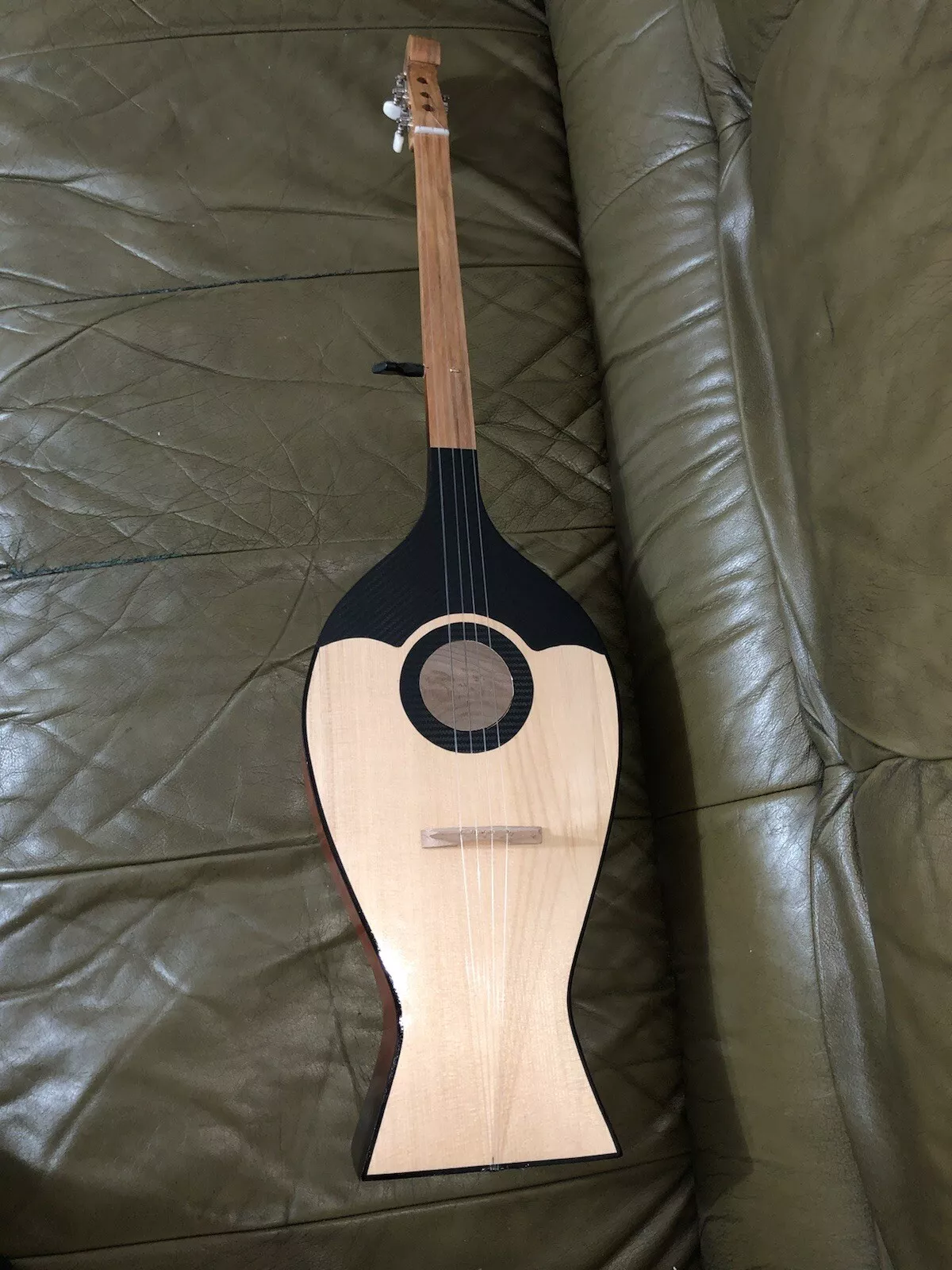Chonguri
Plucked Instruments
Asia
Between 1001 and 1900 AD
Video
The Chonguri, a plucked long-necked lute, stands as a captivating testament to the rich musical heritage of the Caucasus region, particularly Georgia. This instrument, with its distinctive sound and elegant design, has played a significant role in the cultural and social life of the people for centuries. It’s more than just a musical instrument; it’s a vessel of history, tradition, and emotion, reflecting the soul of Georgian folk music.
Description of the Chonguri
The Chonguri is a long-necked, fretless lute characterized by its pear-shaped or oval soundbox, a slender neck, and a small pegbox. Typically, it features three or four strings, though variations exist. The instrument is held horizontally or slightly angled, with the player plucking the strings with their fingers. The sound produced is mellow, resonant, and often described as melancholic or soulful. The Chonguri’s visual appeal is enhanced by its often intricate decorations, which can include inlaid wood, bone, or other materials. The soundboard, usually made of thin spruce, contributes to the instrument’s warm and nuanced tone. The overall aesthetic of the Chonguri reflects the craftsmanship and artistic sensibilities of the region.
Type of Instrument
The Chonguri belongs to the lute family, specifically the long-necked lute category. It shares similarities with other plucked string instruments found in various cultures, but it possesses unique features that distinguish it. The absence of frets allows for a wide range of tonal inflections and glissandos, characteristic of Georgian folk music. The Chonguri is typically used to accompany singing, often in polyphonic vocal traditions, which are a hallmark of Georgian musical culture. The instrument’s role is not merely to provide a harmonic backdrop but to actively participate in the musical dialogue, enhancing the emotional depth of the performance.
History of the Chonguri
The Chonguri’s origins are deeply rooted in the Caucasus region, a geographical area situated between the Black Sea and the Caspian Sea, encompassing Georgia, Armenia, Azerbaijan, and parts of Russia. This region has served as a crossroads of civilizations, resulting in a rich tapestry of cultural influences. The Chonguri, in particular, is strongly associated with Georgia, where it has been an integral part of folk music traditions for centuries.While precise dating of the Chonguri’s emergence is difficult, it is believed to have evolved over several centuries, with its roots tracing back to the medieval period. Evidence suggests that similar long-necked lutes existed in the region as early as the 12th or 13th century. Over time, the Chonguri underwent modifications in design and construction, reflecting the evolving musical tastes and craftsmanship of the Georgian people. By the 18th and 19th centuries, the Chonguri had become a prominent instrument in Georgian folk music, playing a crucial role in social gatherings, celebrations, and storytelling. During the Soviet era, the Chonguri, like many other folk instruments, faced challenges due to the suppression of traditional cultures. However, it experienced a resurgence in popularity following Georgia’s independence, as part of a broader revival of national identity and cultural heritage.
Construction and Design
Materials: The construction of the Chonguri involves the use of various materials, each carefully selected for its acoustic properties and aesthetic qualities. The soundboard, which plays a critical role in sound production, is typically made of thin, finely grained spruce. The back and sides of the soundbox are often crafted from hardwoods such as mulberry, walnut, or maple. The neck, which must be strong and stable, is usually made from a dense hardwood like beech or walnut. The pegs, used for tuning the strings, can be made of wood, bone, or metal. The strings themselves were traditionally made of silk or gut, but modern instruments often use nylon or metal strings.
Process: The construction process of a Chonguri is a meticulous and time-consuming endeavor, requiring skilled craftsmanship. The soundbox is typically built by shaping and joining individual pieces of wood, forming a rounded or oval shape. The soundboard is then carefully fitted and glued to the soundbox, ensuring a tight and seamless connection. The neck is shaped and attached to the soundbox, and the pegbox is carved and fitted with tuning pegs. The bridge, which supports the strings, is positioned on the soundboard. The strings are then attached and tuned. The final stages involve finishing and decorating the instrument, which may include polishing, varnishing, and the addition of inlaid designs.
Design Elements: The design of the Chonguri often reflects the aesthetic preferences and cultural symbols of the region. Many instruments feature intricate inlaid patterns, geometric designs, or floral motifs. These decorations may be made of contrasting woods, bone, or other materials. The shape of the soundbox, the length of the neck, and the design of the pegbox can vary, reflecting regional styles and individual craftsmanship. Some Chonguri instruments feature a small soundhole on the soundboard, while others may have multiple smaller holes or no soundhole at all. The overall design of the Chonguri is characterized by its elegance, simplicity, and functionality.
Types of Chonguri
While the fundamental characteristics of the Chonguri remain consistent, variations exist in terms of size, number of strings, and regional styles.
Three-String Chonguri: The most common type of Chonguri features three strings. This configuration is widely used in various regions of Georgia and is considered the standard form of the instrument. The three-string Chonguri is versatile and well-suited for accompanying a wide range of vocal styles and musical genres.
Four-String Chonguri: Some Chonguri instruments have four strings, which provide a wider range of tonal possibilities and harmonic complexity. This type of Chonguri is often favored by skilled musicians who seek to explore more intricate musical arrangements. The addition of a fourth string allows for more elaborate chord voicings and melodic variations.
Regional Variations: Regional variations in Chonguri design and playing styles exist throughout Georgia. For example, Chonguri from different regions may have slightly different soundbox shapes, neck lengths, or decorative elements. These variations reflect the unique cultural and musical traditions of each region. Additionally, playing techniques and musical styles may differ, with some regions emphasizing certain melodic patterns or rhythmic variations.
Characteristics of the Chonguri
The Chonguri is renowned for its mellow, resonant, and often melancholic sound. The absence of frets allows for a wide range of tonal inflections and glissandos, creating a expressive and nuanced sound. The soundboard, made of thin spruce, contributes to the warm and clear tone. The overall sound quality of the Chonguri is well-suited for accompanying singing, particularly the polyphonic vocal traditions of Georgia.
Playing Techniques and Sound Modifications
Mastering the Chonguri involves a combination of intricate fingerwork and a keen understanding of the instrument’s tonal capabilities. The playing techniques employed are diverse, ranging from simple strumming to complex melodic phrases. Strumming, often used to provide rhythmic accompaniment, involves sweeping the fingers or a pick across the strings, creating a rich harmonic backdrop. More intricate melodies are produced through fingerpicking, where individual strings are plucked to create distinct notes and phrases. The left hand manipulates the strings by pressing them against the frets, altering the pitch and creating melodic variations. Glissando, a technique involving sliding the fingers along the strings, adds a lyrical fluidity to the music, while trills and vibrato enhance the expressive quality of the notes. The use of different finger positions and pressure allows players to achieve a wide range of tonal nuances. Sound modifications are achieved through various techniques, including the use of different plectrums, finger positions, and playing styles. The choice of plectrum, whether made of feather, bone, or plastic, influences the tone and attack of the notes. Finger positions on the neck can alter the timbre and sustain of the sound, while variations in playing style, such as using a more percussive or legato approach, contribute to the overall musical expression. The use of open strings, coupled with fretted notes, creates a rich harmonic resonance, adding depth and complexity to the music. Additionally, players might employ muting techniques to dampen certain strings, creating rhythmic accents and tonal contrasts. The Chonguri’s design, with its resonant body and flexible strings, allows for a wide range of dynamic and expressive possibilities, making it a versatile instrument in the hands of a skilled musician.
Applications in Music
The Chonguri’s applications in music are diverse, spanning solo performances, ensemble playing, and accompaniment for vocal traditions. In Georgian folk music, it often serves as a solo instrument, showcasing the player’s virtuosity and expressive capabilities. Solo performances typically feature intricate melodies and improvisations, highlighting the Chonguri’s lyrical and resonant qualities. In ensemble settings, the Chonguri blends harmoniously with other traditional Georgian instruments, such as the Panduri and the Salamuri, creating rich and complex musical textures. It frequently accompanies vocal performances, providing a supportive harmonic and rhythmic foundation for traditional Georgian polyphonic singing. The instrument’s role in vocal accompaniment is particularly significant, as it enhances the emotional depth and narrative quality of the songs. The Chonguri is also used in various cultural events and celebrations, including weddings, festivals, and religious ceremonies, where it contributes to the festive atmosphere and reinforces cultural traditions. Its versatility allows it to adapt to different musical genres and styles, from traditional folk melodies to contemporary interpretations. In modern Georgian music, the Chonguri has found a place in fusion and experimental projects, where it is combined with other instruments and musical styles to create innovative and unique sounds. Its enduring popularity and adaptability ensure its continued relevance in both traditional and contemporary musical contexts.
Most Influential Players
The Chonguri’s legacy is enriched by the contributions of numerous influential players who have shaped its development and popularization. These musicians, through their mastery of the instrument and their innovative approaches, have left an indelible mark on Georgian musical culture. One notable figure is Anzor Erkomaishvili, a renowned musician and scholar who dedicated his life to preserving and promoting Georgian folk music, including the Chonguri. His performances and recordings have served as a vital resource for aspiring Chonguri players, ensuring the transmission of traditional techniques and styles. Another influential player is Rostom Saginashvili, whose virtuosity and expressive playing style have inspired generations of musicians. His contributions to the development of Chonguri technique and repertoire have expanded the instrument’s expressive possibilities. Vakhtang Tatishvili, another prominent figure, is known for his innovative interpretations of traditional melodies and his efforts to integrate the Chonguri into contemporary musical contexts. His work has broadened the instrument’s appeal and introduced it to a wider audience. These musicians, along with many others, have played a crucial role in preserving and promoting the Chonguri, ensuring its continued relevance and popularity in Georgian musical culture. Their dedication and artistry have contributed to the instrument’s enduring legacy and its status as a symbol of Georgian musical identity.
Maintenance and Care
Proper maintenance and care are essential for preserving the Chonguri’s sound quality and longevity. The instrument’s delicate construction requires careful handling and storage to prevent damage. Regular cleaning is crucial for removing dust, dirt, and oils that can accumulate on the surface and affect the sound. A soft cloth should be used to gently wipe the body, neck, and soundboard after each use. The strings, which are susceptible to wear and tear, should be replaced periodically to maintain optimal tone and intonation. The tuning pegs, which are responsible for maintaining the string tension, should be checked regularly and lubricated as needed to ensure smooth operation. The Chonguri should be stored in a dry, temperature-controlled environment to prevent warping and cracking of the wood. Extreme temperature and humidity fluctuations can cause significant damage to the instrument. A protective case is recommended for storing and transporting the Chonguri, providing a barrier against physical damage and environmental factors. Regular inspections by a qualified luthier are essential for identifying and addressing any potential issues, such as cracks, loose joints, or warping. Professional maintenance, including adjusting the bridge, nut, and soundpost, can ensure the instrument’s optimal performance and longevity. By adhering to these maintenance and care practices, Chonguri players can preserve the instrument’s sound quality and ensure its continued enjoyment for generations to come.
Cultural Significance
The Chonguri holds deep cultural significance in Georgia, serving as a symbol of national identity and cultural heritage. It is an integral part of folk music traditions, playing a crucial role in social gatherings, celebrations, and storytelling. The Chonguri is often used to accompany traditional songs and dances, enhancing the emotional impact of the performance. The instrument is also associated with various cultural rituals and ceremonies, reflecting its spiritual and symbolic importance. The Chonguri plays an important role in transmitting cultural knowledge and values from one generation to the next, preserving the rich musical heritage of Georgia.
Role in Georgian Polyphony: Georgian polyphony, a unique and complex vocal tradition, is a UNESCO Intangible Cultural Heritage of Humanity. The Chonguri plays a vital role in accompanying and supporting these polyphonic vocal performances. The instrument’s melodies and harmonies complement the vocal lines, creating a rich and layered musical texture. The Chonguri’s ability to produce subtle tonal inflections and glissandos enhances the expressiveness and emotional depth of the polyphonic singing. The instrument’s role is not merely to provide a harmonic backdrop but to actively participate in the musical dialogue, contributing to the overall musical structure and emotional impact.
Preservation and Revival: In recent decades, there has been a renewed interest in the Chonguri and other Georgian folk instruments, as part of a broader revival of national identity and cultural heritage. Efforts are underway to preserve and promote the Chonguri through education, performance, and research. Traditional music schools and cultural organizations offer instruction in Chonguri playing and construction. Festivals and concerts showcase the instrument’s versatility and beauty. Research into the history and cultural significance of the Chonguri contributes to a deeper understanding of its role in Georgian musical culture. The preservation and revival of the Chonguri are essential for ensuring that this valuable cultural heritage is passed on to future generations.
FAQ
What is the origin and history of the Chonguri?
The Chonguri is a traditional Georgian stringed instrument, primarily used in folk music. It evolved from ancient lutes and is closely related to other Caucasian instruments. Historically, it accompanied polyphonic singing in Georgia’s rural areas. Its simple design and warm tone make it a staple in Georgian music.
What materials are used to construct the Chonguri?
The Chonguri is typically made from a single piece of wood, such as walnut or maple. The body is hollowed out, with a wooden soundboard and gut or nylon strings. Traditional versions feature hand-carved decorations. The instrument’s lightweight build enhances its resonant sound.
What are the playing techniques and applications of the Chonguri?
The Chonguri is played by plucking or strumming with fingers, producing a soft, melodic tone. It is often used for accompaniment in folk songs and storytelling. Players use various fingerpicking patterns to create rhythmic and harmonic textures. Its role is essential in traditional Georgian ensembles.
 Links
Links
References
Other Instrument
Categories




















